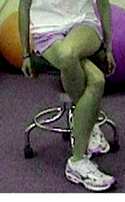Woman’s One-Sided Worries

Over the years, I’ve noticed that my female patients experience unilateral hip and/or knee pain (pain on one side of the body) more often than my male patients do. This predisposition has been observed by others as well
Lateral hip pain is typically called bursitis, piriformis syndrome, or gluteal tendinopathy. Studies have shown the incidence of lateral hip pain is more frequent in females. Knee pain is typically called patella femoral arthralgia or IT band syndrome. Studies have shown patellofemoral pain syndromes is twice as likely in females compared to males.
This research confirms the pattern. But without more understanding of its cause, patients seek pain relief without learning how to prevent their pain in the first place. So, why is it that females experience more frequent pain on just one side of the body?
Yes, females have a wider pelvis and different hormones than males but this does not explain why hip and/or knee pain occurs on one side of the body. After all, the female pelvis is wider on both sides, and female hormones are equally distributed between the right and left sides of the body.
Over the years, I’ve observed the following contributing causes to unilateral hip and knee pain in woman
Women are more likely to wear dresses and sit with their knees crossed, a posture that can easily become a habit. My observation is hand dominance whether an individual is right handed or left handed will influence crossing of legs. Right handed individuals will cross the right leg over the left more frequently than crossing left leg over right. This provides a better platform to place a clip board on the thigh in order to write. The weight of the upper leg pulls the lower leg across the mid-line of the body, resulting in a chronic stretching of the bottom leg’s hip muscles. The picture below illustrates excessive stretching of the hip muscles on the right side.

The bottom leg then develops a “stretch weakness,” which is an alteration of the normal relationship between a muscle’s length and its ability to generate force. A muscle in which the length is longer than normal has difficulty generating force in the last 5% to 10% of the range of motion. This is analogous to a sprung spring that has become overstretched or too loose. If you hip muscle is the metal spring on a screen door, than stretch weakness would mean increased space between the coils of the metal spring. The spring will be ineffective fully closing the door.
Women are more likely to spend time with a toddler[s] perched on their hip. Carrying a child on one hip keep the opposite hand free to grab the phone, write notes, or reach for another child. This posture leads to chronic stretching of the hip muscles on one side of the body. This kind of asymmetrical standing posture often occurs even if a toddler is not around. We often prefer to shift weight on to one leg more than the other when it is necessary to stand for a long time. The picture below illustrates posture, which stretching the right hip muscles.

A physical therapist can help improve unilateral hip and/or knee pain by designing a program that includes traditional strengthening exercises, neuromuscular education, and gait training. It is important that strengthening exercises focus specifically on the last 5% to 10% of the available range of motion.
Given the above observations it is also critical to address potential habitual contributing factors, with concerted effort made to minimize or avoid habitual postures, positions and activities which stretch the hip muscles asymmetrically.
The habits and postures discussed in this article are specific to women. Asymmetrical stretch weakness dose occur in men as well, but in my experience, it is less frequent and results from activities other than wearing dresses and carrying toddlers.
There are two steps to altering habitual postures, positions, and activities. First, you must recognize the habits; then you must stop or minimize them. The more difficult step is the recognition. So ask for assistance. Show your friends or family the postures you want to avoid, and have them point it out when they observe those postures. Teenage children love to help with this.
Damien Howell Physical Therapy – 804-647-9499 – Fax: 866-879-8591 At-Home, At Office, At Fitness Facility, I come to you, I do home visits, or Online Damien@damienhowellpt.com
